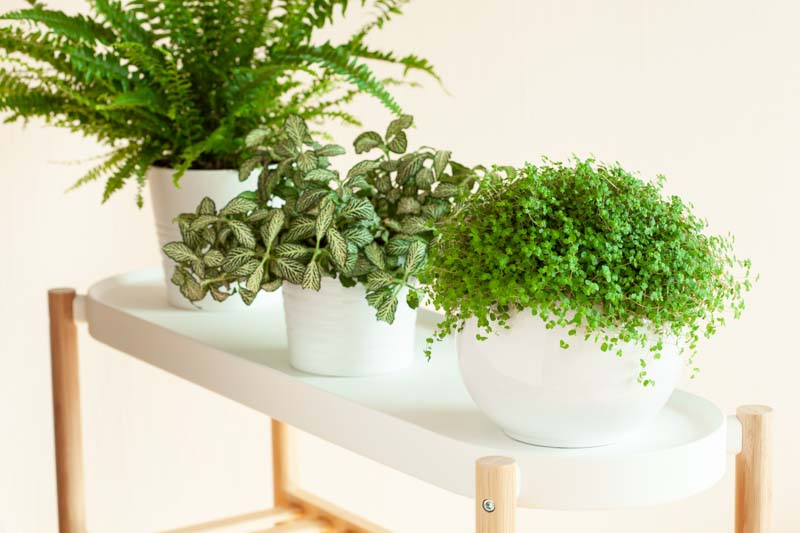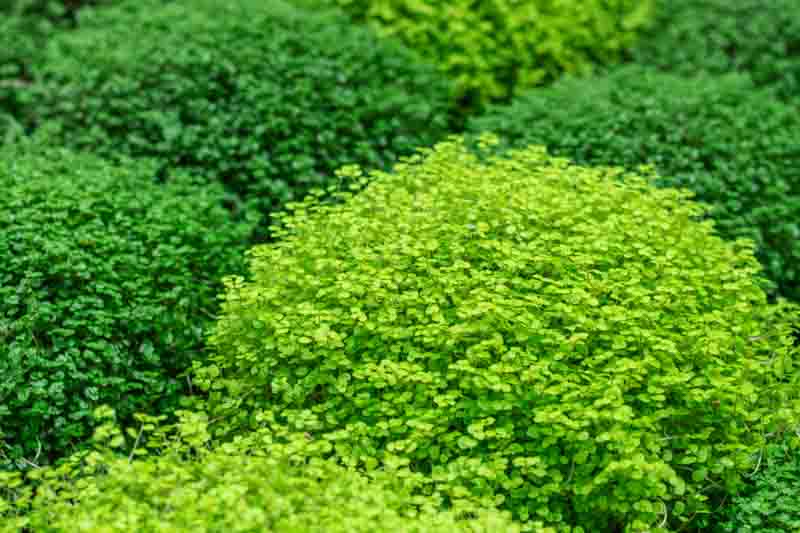Angel's Tears, Baby's Tears, Corsican Carpet, Irish Moss, Japanese Moss, Mind-Your-Own-Business, Paddys Wig, Peace-in-the-Home, Pollyanna Vine, Helxine soleirolii
Soleirolia soleirolii, commonly known as Baby’s Tears or Mind-Your-Own-Business, is a charming, mat-forming perennial known for its delicate and lush appearance. Due to its versatility and ease of care, it has found a beloved place in many gardens and homes worldwide.
Baby’s Tears boasts tiny, round, green leaves closely packed on slender, creeping stems. This dense leaf cover gives it a soft, velvety texture, making it highly sought after for its aesthetic appeal.
Native: This plant is native to the Mediterranean, thriving in the damp, shaded areas of Corsica, Sardinia, and Northern Italy, which explains its preference for moist conditions and indirect light. It belongs to the nettle family (Urticaceae) along with Pilea plants.
Plant Type and Habit: Baby’s Tears is a fast-growing, evergreen perennial that forms a lush carpet of foliage and spreads vigorously under the right conditions. Its growth habit makes it an excellent choice for ground cover in gardens or as a decorative indoor plant.
Size: In terms of size, Baby’s Tears is modest, with a height of typically no more than 3-6 inches (7-15 cm), but can spread 3-6 feet (90-180 cm) or indefinitely if allowed, covering the ground or cascading over the edges of containers.
Flowers: Baby’s Tears’s flowers are minuscule, white, and inconspicuous, often going unnoticed against the dense foliage. Flowering occurs in late spring to early summer, though the plant is primarily grown for its foliage rather than its blooms.
Foliage: Its miniature, rounded leaves form a vibrant green carpet, offering tranquility and freshness. Carried on delicate, rooting stems—either pink or green—they captivate with simplicity. Select varieties boast golden or variegated foliage, enhancing its ornamental charm.
Hardiness: Baby’s Tears is hardy in USDA zones 9-11 and tolerates humidity. It is evergreen in zone 10 above and will die back but resprout in zone 9. In cooler climates, it is often grown as an annual or kept indoors.
Uses: Ideal for terrariums, fairy gardens, hanging baskets, or as a ground cover (tolerates foot traffic) in shaded garden areas. Resembling moss it’s also used to soften the edges of pathways or to cover the soil surface in container plantings.
Toxicity: Baby’s Tears is non-toxic to humans and pets, making it a safe choice for households with children and animals.
Invasiveness: In suitable climates, it can become invasive if not contained. Its ability to spread quickly through rooting stems means it can overtake areas if not monitored. Once established outdoors, removing the plant can be challenging. Despite efforts to clear it away, numerous small stems often remain undetected, allowing the plant to regenerate and persist in the area.
Benefits: Its dense foliage can help suppress weeds in garden settings and is valued for its air-purifying qualities indoors. Its presence can add a sense of tranquility and natural beauty to any space.

Growing Baby’s Tears both indoors and outdoors requires attention to moisture, light, and soil conditions to replicate its native Mediterranean habitat.
Light: Indoors, Baby’s Tears prefer bright, indirect light. Place them near a window that receives filtered sunlight to avoid the scorching midday sun, which can damage the delicate leaves.
Soil: Use a well-draining, peat-based potting mix. The goal is to retain moisture without water stagnation.
Water: Keep the soil consistently moist but not waterlogged. Water when the top layer of soil feels slightly dry to the touch. Overwatering can lead to root rot, so ensure good drainage.
Temperature: Baby’s Tears thrive in average room temperatures between 60°F and 75°F (16°C to 24°C). Avoid exposure to drafts and sudden temperature changes.
Humidity: This plant loves high humidity. In dry indoor environments, increase humidity by misting the plant regularly, placing it on a pebble tray filled with water, or using a humidifier.
Feeding: Fertilize lightly with a balanced liquid fertilizer every 4-6 weeks during the growing season (spring and summer).
Potting: Choose a pot with drainage holes to prevent water accumulation. Repot in spring if the plant outgrows its container or to refresh the soil.
Light: In garden settings, plant Baby’s Tears in a location that receives partial to full shade. Too much direct sunlight can scorch the leaves.
Soil: Plant in rich, well-draining soil. Incorporating compost or peat moss can help improve soil structure and moisture retention.
Watering: Water regularly to keep the soil consistently moist, especially during dry periods. Baby’s Tears cannot tolerate drought.
Mulching: Apply a layer of organic mulch around the plants to help retain soil moisture and suppress weeds.
Spacing: Space plants about 3-6 feet apart (90-180 cm) to allow for spreading.
Hardiness Zone: Baby’s Tears is hardy in USDA zones 9-11. In cooler climates, it can be grown as an annual or brought indoors for the winter.
Landscape Use: Excellent as a ground cover in shaded areas, around ponds, or in woodland gardens. Its dense growth habit suppresses weeds and covers the ground quickly.
Propagating Baby’s Tears is a simple and effective way to create new plants from your existing ones. This plant can be easily propagated through division. This is best done in spring or early summer when the plant is actively growing.
Remove the Plant: Gently take the plant out of its pot and carefully loosen the soil around the roots.
Divide the Plant: Identify natural divisions in the root ball and gently tease them apart with your hands or use a clean knife for larger plants. Ensure each division has a good amount of roots and foliage.
Repot: Plant each division in its own pot filled with a well-draining potting mix suitable for houseplants. Water well to help settle the soil around the roots.
Care After Division: Keep the soil consistently moist and place the pots in a location with bright, indirect light. High humidity is beneficial for recovery and growth.

Baby’s Tears is generally easy to care for, but like all plants, it can encounter pests, diseases, and common problems.
Spider Mites: These tiny pests thrive in dry conditions and can cause the leaves to look speckled and dull. If an infestation occurs, increase humidity around the plant and treat it with insecticidal soap or neem oil.
Mealybugs: Identified by their cottony white appearance, they suck sap from the plant, weakening it. Remove them manually with a cotton swab dipped in alcohol or use insecticidal soap.
Scale insects: Hard or soft-bodied insects that attach themselves to the stems or leaves, causing yellowing and growth stunting. Scrape off with a fingernail or use a cotton swab dipped in rubbing alcohol. Insecticidal soap or neem oil may also be used.
Aphids: These small, sap-sucking insects can cluster on new growth or the undersides of leaves, causing yellowing or distorted growth. To treat infestations, rinse the plant with water or use insecticidal soap.
Root rot: Overwatering is the primary cause, leading to mushy stems and root decay. Ensure proper drainage and allow the soil surface to dry slightly between waterings.
Gray mold or botrytis: This fungal disease causes a gray, fuzzy mold on leaves, especially in cool, wet conditions. Improve air circulation, reduce humidity, and remove affected parts promptly.
Yellowing Leaves: Can be caused by both overwatering and underwatering. Adjust your watering schedule to ensure the soil remains moist but not waterlogged.
Leggy Growth: Insufficient light may cause Baby’s Tears to stretch toward the light source. Provide bright, indirect light to promote compact growth.
Browning Leaf Edges: Low humidity can cause the leaf edges to brown. Increase humidity levels through misting, pebble trays, or a humidifier.
| Hardiness |
9 - 11 |
|---|---|
| Plant Type | Houseplants, Perennials |
| Plant Family | Urticaceae |
| Exposure | Partial Sun, Shade |
| Season of Interest |
Spring (Early, Mid, Late) Summer (Early, Mid, Late) Fall Winter |
| Height |
3" - 6" (8cm - 15cm) |
| Spread |
3' - 6' (90cm - 180cm) |
| Maintenance | Low |
| Water Needs | Average |
| Soil Type | Loam, Sand, Chalk, Clay |
| Soil pH | Acid, Neutral, Alkaline |
| Soil Drainage | Moist but Well-Drained, Well-Drained |
| Characteristics | Showy, Evergreen |
| Tolerance | Full Shade |
| Garden Uses | Banks And Slopes, Ground Covers, Hanging Baskets, Patio And Containers, Underplanting Roses And Shrubs |
| Garden Styles | Mediterranean Garden, Gravel and Rock Garden |
| Hardiness |
9 - 11 |
|---|---|
| Plant Type | Houseplants, Perennials |
| Plant Family | Urticaceae |
| Exposure | Partial Sun, Shade |
| Season of Interest |
Spring (Early, Mid, Late) Summer (Early, Mid, Late) Fall Winter |
| Height |
3" - 6" (8cm - 15cm) |
| Spread |
3' - 6' (90cm - 180cm) |
| Maintenance | Low |
| Water Needs | Average |
| Soil Type | Loam, Sand, Chalk, Clay |
| Soil pH | Acid, Neutral, Alkaline |
| Soil Drainage | Moist but Well-Drained, Well-Drained |
| Characteristics | Showy, Evergreen |
| Tolerance | Full Shade |
| Garden Uses | Banks And Slopes, Ground Covers, Hanging Baskets, Patio And Containers, Underplanting Roses And Shrubs |
| Garden Styles | Mediterranean Garden, Gravel and Rock Garden |
How many Soleirolia soleirolii (Baby’s Tears) do I need for my garden?
| Plant | Quantity | |
|---|---|---|
| Soleirolia soleirolii (Baby’s Tears) | N/A | Buy Plants |
Create a membership account to save your garden designs and to view them on any device.
Becoming a contributing member of Gardenia is easy and can be done in just a few minutes. If you provide us with your name, email address and the payment of a modest $25 annual membership fee, you will become a full member, enabling you to design and save up to 25 of your garden design ideas.
Join now and start creating your dream garden!
Create a membership account to save your garden designs and to view them on any device.
Becoming a contributing member of Gardenia is easy and can be done in just a few minutes. If you provide us with your name, email address and the payment of a modest $25 annual membership fee, you will become a full member, enabling you to design and save up to 25 of your garden design ideas.
Join now and start creating your dream garden!